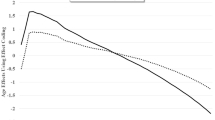Abstract
The recent controversy over the age relationship with criminal behavior can be traced to Hirschi and Gottfredson's (Am. J. Sociol. 89, 552–584, 1983) failure to define “invariance.” In this paper, I distinguish two types of invariance—parametric andmathematical form— that explains both the pattern of stability claimed by Hirschi and Gottfredson and the pattern of variability observed in more recent research. I then directly test for each type of invariance using age-specific arrest data for index offenses in the United States from 1952 to 1987. The results are largely consistent with recent research showing variability in the characteristics (i.e., parameters) of the age distribution of crime, but at the same time, the results provide evidence for a persistent, underlying mathematical form to the age distribution of crime, regardless of year or offense type.
Similar content being viewed by others
References
Coale, A. J., and McNeil, D. R. (1972). The distribution by age of the frequency of first marriage in a female cohort.J. Am. Stat. Assoc. 67: 743–749.
Cohen, L. E., and Land, K. C. (1987). Age structure and crime: Symmetry versus asymmetry and the projection of crime rates through the 1990s.Am. Sociol Rev. 52: 170–183.
Farrington, D. P. (1986). Age and crime, in Tonry, M., and Morris, N. (eds.),Crime and Justice: An Annual Review of Research, Vol. 7, pp. 189–250.
Federal Bureau of Investigation (1953, 1958, 1963, 1968, 1973, 1978, 1983, 1988).Uniform Crime Reports: Crime in the United States, U.S. Government Printing Office, Washington, DC.
Goring, C. (1913).The English Convict, Patterson Smith, Montclair, NJ.
Gottfredson, M., and Hirschi, T. (1988). Science, public policy, and the career paradigm.Criminology 26: 37–55.
Greenberg, D. F. (1977). Delinquency and the age structure of society.Contemp. Cris. 1: 189–223.
Greenberg, D. F. (1985). Age, crime, and social explanation.Am. J. Sociol. 91: 1–21.
Greenberg, D. F. (1991). Modeling criminal careers.Criminology 29: 17–46.
Greenberg, D. F., and Larkin, N. J. (1985). Age-cohort analysis of arrest rates.J. Quant. Criminol. 1: 227–240.
Hindelang, M. J., Hirschi, T., and Weis, J. G. (1981).Measuring Delinquency, Sage, Beverly Hills, CA.
Hirschi, T., and Gottfredson, M. R. (1983). Age and the explanation of crime.Am. J. Sociol. 89: 552–584.
Hirschi, T., and Gottfredson, M. R. (1985). Age and crime, logic and scholarship: Comment on Greenberg.Am. J. Sociol. 91: 22–27.
Klepinger, D. H., and Weis, J. G. (1985). Projecting crime rates: An age, period, and cohort model using ARIMA techniques.J. Quant. Criminol. 1: 387–416.
Land, K. C., McCall, P. L., and Cohen, L. E. (1989). Age structure and crime: Is there a connection? Paper presented at the Annual Meetings of the American Sociological Association, San Francisco.
O'Brien, R. M. (1989). Relative cohort size and age-specific crime rates: An age-period-relative-cohort-size model.Criminology 27: 57–78.
Rapoport, A. (1983).Mathematical Models in the Social and Behavioral Sciences, John Wiley and Sons, New York.
Rowe, D. C., Osgood, D. W., and Nicewander, A. W. (1990). A latent trait approach to unifying criminal careers.Criminology 28: 237–270.
Shavit, Y., and Rattner, A. (1988). Age, crime, and the early life course.Am J. Sociol. 93: 1457–1470.
Steffensmeier, D. J., and Harer, M. D. (1986). Is the crime rate really falling? An “aging” U.S. population and its impact on the nation's crime rate, 1980–1984.J. Res. Crime Delinq. 24: 23–48.
Steffensmeier, D., and Streifel, C. (1991). Age, gender, and crime across three historical periods: 1935, 1960, and 1985.Soc. Forces 69: 869–894.
Steffensmeier, D. J., Streifel, C., and Harer, M. D. (1987). Relative cohort size and youth crime in the United States, 1953–1984.Am Sociol. Rev. 52: 702–710.
Steffensmeier, D. J., Allan, E. A., Harer, M. D., and Streifel, C. (1989). Age and the distribution of crime.Am. J. Sociol. 94: 803–831.
Thompson, P. A., Bell, W. R., Long, J. F., and Miller, R. B. (1989). Multivariate time series projections of parameterized age-specific fertility rates.J. Am. Stat. Assoc. 84: 689–699.
U.S. Department of Commerce, Bureau of the Census (1965).Current Population Reports: Estimates of the Population of the United States by Single Years of Age, Color, and Sex 1990 to 1959, U.S. Government Printing Office, Washington, DC.
U.S. Department of Commerce, Bureau of the Census (1974).Current Population Reports: Estimates of the Population of the United States, by Age, Sex, and Race: April 1, 1960 to July 1, 1973, U.S. Government Printing Office, Washington, DC.
U.S. Department of Commerce, Bureau of the Census (1981).Current Population Reports: Estimates of the Population of the United States by Age, Sex, and Race, 1970–1981, U.S. Government Printing Office, Washington, DC.
U.S. Department of Commerce, Bureau of the Census (1987).Current Population Reports: Estimates of the Population of the United States by Age, Sex, and Race, 1980–1987, U.S. Government Printing Office, Washington, DC.
Watkins, S. C., and McCarthy, J. (1980). Female life cycle in a Belgian commune: LaHulpe, 1847–1866.J. Fam. Hist. 5: 167–179.
Wilson, N. K. (1972).Risk Ratios in Juvenile Delinquency, Unpublished Ph.D. Dissertation, Department of Sociology, University of Tennessee, University Microfilms, Ann Arbor, MI.
Author information
Authors and Affiliations
Rights and permissions
About this article
Cite this article
Britt, C.L. Constancy and change in the U.S. age distribution of crime: A test of the “invariance hypothesis”. J Quant Criminol 8, 175–187 (1992). https://doi.org/10.1007/BF01066743
Issue Date:
DOI: https://doi.org/10.1007/BF01066743




